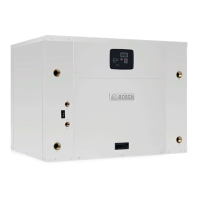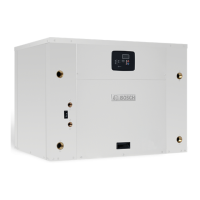Subject to change without prior notice Revised 03-11
6 720 220 047
4
TW Series / Water to Water
INITIAL INSPECTION
Be certain to inspect all cartons or crates on each
unit as received at the job site before signing the
freight bill. Verify that all items have been received
and that there is no visible damage; note any
shortages or damage on all copies of the freight
bill. In the event of damage or shortage, remember
that the purchaser is responsible for ling the
necessary claims with the carrier. Concealed
damage not discovered until after removing the
units from the packaging must be reported to the
carrier within 24 hours of receipt.
GENERAL DESCRIPTION
The Water-to-Water series unit is a heat pump that
provides the best combination of performance and
efciency available. Safety devices are built into
each unit to provide the maximum system
protection possible when the unit is properly
installed and maintained.
The Water-to-Water series units are Underwriters
Laboratories (UL) and (cUL) listed for safety. The
Water-to-Water series units are designed to operate
with entering source liquid temperature between
25° F and 110° F. (see specications data sheets
for limits).
For well water applications, the minimum
source EWT is 50˚ F, with sufcient water ow
to prevent freezing. Antifreeze solution is
required for all closed loop applications.
Cooling Tower/Boiler and Earth Coupled (Geo
Thermal) applications should have sufcient
antifreeze solution to protect against extreme
conditions and equipment failure. Frozen water
coils are not covered under warranty.
MOVING AND STORAGE
If the equipment is not needed for immediate
installation upon its arrival at the job site, it should
be left in its shipping carton and stored in a clean,
dry area. Units must only be stored or moved in the
normal upright position as indicated by the “UP”
arrows on each carton at all times.
SAFETY CONSIDERATIONS
Installation and servicing of this equipment can be
hazardous due to system pressure and electrical
components. Only trained and qualied personnel
should install, repair, or service the equipment.
Before performing service or maintenance
operations on the system, turn off main power
to the unit. Electrical shock could cause
personal injury or death.
TW Series R-410A refrigerant systems operate
at higher pressures than standard R-22
systems. Do not use R-22 service equipment or
components on R-410A equipment.
When working on equipment, always observe
precautions described in the literature, tags, and
labels attached to the unit. Follow all safety codes.
Wear safety glasses and work gloves. Use a
quenching cloth for brazing, and place a re
extinguisher close to the work area.
LOCATION
The unit should be centrally located with respect to
the distribution system. The unit should be
installed in an indoor area that allows easy removal
of the access panels, and has enough room for
service personnel to perform maintenance or
repair. Provide sufcient room to make uid, and
electrical connections. These units are not
approved for outdoor installation; therefore, they
must be installed inside the conditioned structure.
Do not locate in areas that are subject to freezing.
INSTALLATION
The Water-to-Water series unit should be mounted
level on a vibration absorbing pad slightly larger
than the base to minimize vibration transmission to
the building structure. It is not necessary to anchor
the unit to the oor.
If the unit is installed on a oor over a crawl space,
it should not rest on long, unsupported oor joists.
Vibrations may be created in the joists with the
crawl space acting as an amplier box resulting in
undesirable noise. A drain pan is recommended
VIBRATION PAD
FULL SIZE
Initial Inspection

